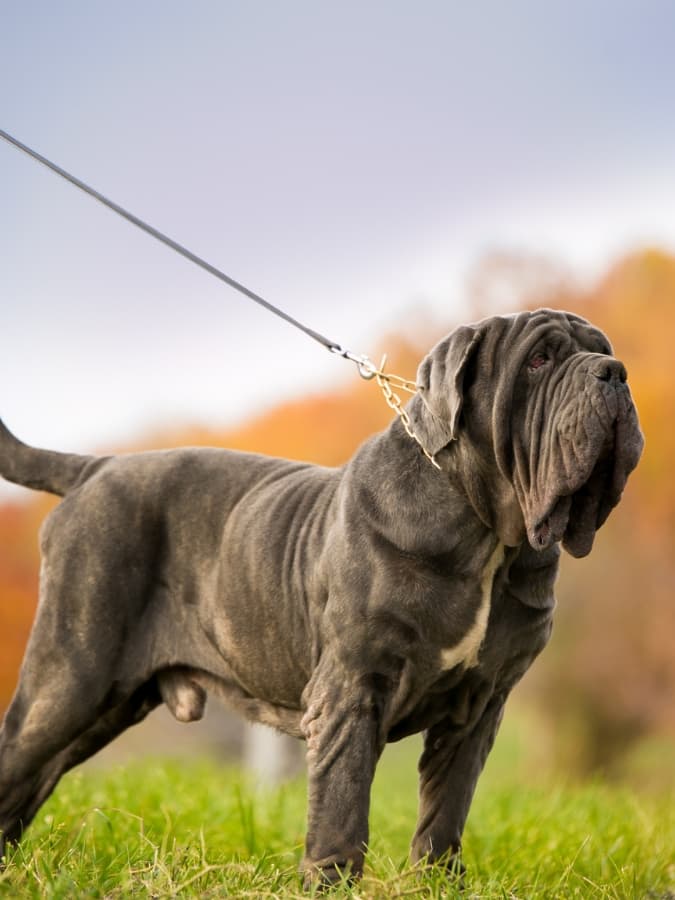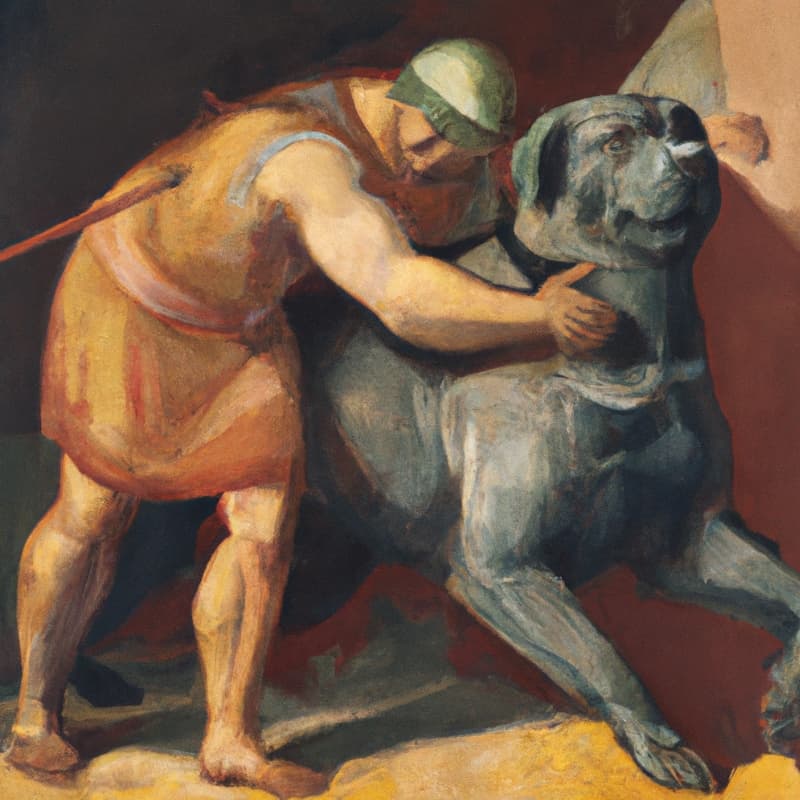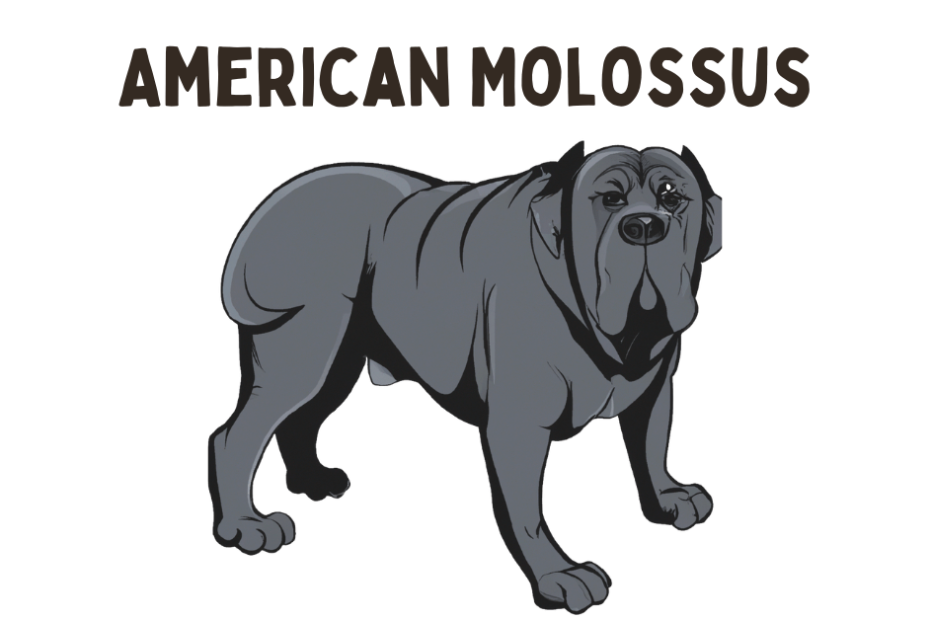Are you ready to meet the world’s largest puppy?
Weighing in at an astonishing 180 pounds at just nine months old, Old World Euphrates, an American Molossus, has set a new world record for the biggest puppy ever.
This breed, which dates back to ancient Greece, has been resurrected by Marcus Curtis, the owner of Old World Molossus, and has inadvertently created the world’s most extensive bloodline.
In this post, we’ll dive into the fascinating history of the American Molossus and discover why it’s breaking barriers in the world of canine genetics.
The American Molossus
Very few animal species produce babies weighing over 175 pounds at nine months old.
This list includes species that you’d probably expect to eclipse this mark – the whale, elephant, and particular types of lions and tigers – and now, thanks to the return of a breed that dates back to 5,000 BC, you can add dogs to this list.
The American Molossus, a newer breed of dog spawned from the original Molossus of ancient Greece, breaks the barriers of what any owner would expect physically from any canine.
Marcus Curtis, the owner of Old World Molossus, has been setting the bar high about resurrecting this old-world breed. In the process, he has inadvertently created the world’s most extensive bloodline.
“The goal was never to breed the biggest dog in the world. We just wanted to bring back the ancient breed. They had to be big – they had to contend with bears, mountain lions, and other attacks.” [1]youtube.com/watch?v=2o6Z0SkkDfw
One of their dogs, Old World Euphrates, tipped the scales at an incredible 180 pounds at nine months – a world record for the world’s most giant puppy.
In fact, the first litter Curtis bred didn’t yield a dog less than 150 pounds by the nine-month mark.
Many people mistake the American Molossus for the Neapolitan Mastiff. They share the same size and general appearance as Neapolitan Mastiffs (including those cute folds of skin).

Upon discovering these breeds are separate, many assume the American Molossus is a new dog breed.
And while the name is new, Curtis has resurrected an ancient breed in the United States.
History of the Molossus
Any Bully-breed dogs and Mastiffs likely have their roots in the Molossus breed.
While the documented record of the existence of this guard dog goes back to the 1800s, it’s widely assumed that these dogs are rooted in the Greek culture of ancient times.
The first assumed origin of the Molossus was 2,000-5,000 BC Ancient Sumer – which would eventually segue into Mesopotamia and Babylon.
Hence, they are sometimes called the Molossus of ancient Mesopotamia or the Mesopotamian Molossus.

These were considered dogs of the Gods and weren’t just used as protection.
They were kept onsite at field hospitals, as their saliva was thought to contain healing powers because of their origins from the ones worshiped by the ancient Sumerians and Babylonians.
Several theories exist regarding the first appearance and use of these massive, larger-than-life dog breeds that personified the Molossian Kingdom.
The dogs became such a representation of the area that the Molossians would ultimately stamp their currency with the likeness of the breed.
One side of introducing Molossus dogs to the region includes roots in Molossia, with Asian dogs shipped in to help guard the ancient Roman Army of Caesar.
Apparently, large numbers of the dog’s ancestors arrived in Molossia from Asia before being discovered by the Roman Army and were ultimately dispatched as the Romans’ personal canine army.

The dogs left behind by the Romans would become the Molossus as the Greek Empire began to take shape.
That’s one story – the other claims that Alexander the Great, during his travels to Asia, happened upon a breed of dog that impressed him so much that the then-young prince shipped them back to his parents – the King and Queen of the Molossian Kingdom.
The official story goes something like this:
In Ancient Greece, there existed a kingdom belonging to a group of individuals known as the Molossians, located in Epirus, a large geographic region located in the Northwest corner of Ancient Greece.
The Ottoman Empire ultimately captured the area and became what is known as present-day Albania, but only after the Molossians warred with Rome unsuccessfully. They were captured and enslaved to mainland Italy.
Nestled in the rocky, jagged mountains and separated by rough terrain and extremely high elevation, the Molossians adopted their own culture separate from traditional Greek culture.
Alexander the Great was a descendant of the Molossians, a testament to the once great and highly regarded people who made up the area.
One thing the Molossians were known for was their great, warrior canine breeds that stood by the mighty soldiers of the area.
Because of the area’s geographic location, constant conflict demanded that the citizens of the area to be well-prepared for attacks from all sides.
This brought forth the need for these giant dog breeds, depicted in statues found in antiquity, which later became known as the Molosser or Molossus.
The Molossi people kept two primary forms of canine – one for hunting that more resembled a Great Dane, and the other, a guardian of the livestock and ultimately partner in battle, the Molossus.
It was written in Greek Mythology that Artemis gifted Procris a dog named Laelaps that never failed to catch its prey – and from this great animal came the Molossus.
And while the latter seems rooted in fiction – the true origin of the ancient Molossus is anyone’s best guess, as we all have statues and slivers of written and word-of-mouth history of working with.
One thing is for certain; the modern-day Mastiff breeds certainly have the Molossus to thank for its solid and dominant genes.
These big dogs required great stature to stand beside their owners in battle and guard themselves against the barrage of attacks from bears, wolves, and other wild animals.
Eventually, the Molossus was bred with other European mountain dogs during the slavery and migration of the Molossian people throughout various high-elevation areas of the continent.
This would form the basis of other giant dogs such as the St. Bernard, Mastiff, Bernese Mountain Dog, and Great Danes.
Does the Molossus Dog Still Exist?
Technically, the Molossus was last spotted sometime in the 1800s. Ironically, this dog’s contribution to the creation of the Mastiff breed ultimately led to its demise.
After centuries and generations of intermingling with other breeds, the Molossus would phase itself out, finally becoming physically extinct in the early 19th century.
Because of its recent proximity, we know much more about the end of the Molossus breed than we know about the origin.
However, there are several working theories regarding the first appearance of these dogs in the Molossian Kingdom.
Physical Appearance
The American Molossus is the revamped and reimagined version of the original Molossus breed.
When asked about the extinction of the Molossus breed, Marcus Curtis, the original breeder of the “new” American Molossus, claimed the dog never truly fell 100% extinct.
And while his theory makes sense, what gives it the most credibility is the product of his years of hard work to recreate the Molossus breed.
“The Molossus genes continued to live on in the Mastiff breeds, from the Tibetan, and other varieties – different Mastiffs carried different traits of the original Molossus [2]youtu.be/ly1t5SkhcHw.”
Marcus Curtis
This is precisely how Curtis would come to produce the incredible physical traits of this once-extinct dog.
How big is the American Molossus?
The full-sized American Molossus can reach weights upwards of 200 pounds. Remember, this breed produced the world record for the largest puppy – the 180-pound 9-month-old behemoth Old World Euphrates.
At full-grown size, these behemoths stand well over 6 feet tall on their hind legs, standing upright. The American Molossus ranges from 28 to 36 inches on all fours – a mind-blowing 3 feet tall.
To put this in perspective, it allows them to sit at eye level with a human sitting in a chair at a dinner table.
The weight of these dogs is very little fat and primarily lean muscle. Many people mistake a loose coat for fat – however, a loose coat is a part of the dog’s breed.
Over generations, the coat took this characteristic to avoid direct bites to the muscle and flesh during battle – with even the most well-placed wounds resulting only in a skin injury.
Coat Type
Again, the coat type of the American Molossus is very loose hanging. This gives the breed an almost Sharpai-type look, even demonstrating some of the characteristic wrinkles around the face.
Most versions of the Molossus contain overlapping segments of loose coat, giving off the appearance of fat rolls.
As far as coat length and texture, these dogs are short-haired with a gleaming coat quality, much like their Mastiff brethren.
Because of the brilliance and length of their coat, shedding isn’t much of an issue, as they tend to have a very healthy coat dynamic.
Coat Color
The American Molossus coat color is one of its trademark characteristics. This breed has a beautiful dark, brindle-patterned coat, similar to a brindle Pit Bull.
The dominant color on the Molossus’ coat is black, with overlapping shades of dark tan and brown. While the pattern is still technically referred to as brindle, it more closely resembles striping instead.
As additional litters have been bred, different coat variations have surfaced, including solid brown, solid black, and a tan-dominant brindle.
Temperament and Personality
The American Molossus has one of the best temperaments out of all dogs in this family. They were selectively bred to be non-dog aggressive and excellent with families, especially young children.
They are natural guard dogs, giving precedence to the family’s young ones, and are known to be easily trainable and follow the children’s commands as well.
The root genetics of the dogs include being guardians of all herds of animals, so they’re vigilant by nature.
Despite their menacing size, these dogs are gentle giants. They have loving personalities, love being close to their owners, and are famous cuddlers.
Health Issues
Because of the relatively young age of this “old world” dog, there is still much to be discovered regarding health issues. However, at the time of publication, few known health problems were associated with this new breed.
Creator Marcus Curtis has stated in multiple interviews that the selectiveness of the breeding process over nearly a decade weeded out numerous genetic inefficiencies, excluding many known health problems of the traditional Mastiff and Neapolitan Mastiff.
It isn’t to say these dogs are void of all health problems, but that, compared to other breeds, they are exceptionally well-kept and of pristine physical condition.
How long does the American Molossus live?
The lifespan of the American Molossus is between 9 and 12 years.
Again, the goal of the genetic development was to create a dog that potentially eclipsed the lifespan of the Neopolitan Mastiff, which is only between 7 and 9 years.
The American Molossus seems to have a life expectancy closer to the Cane Corso, which is also 9 to 12 years.
Are there American Molossus breeders?
Initially, Marcus Curtis, acting as the originator of the American Molossus breed resurrection, was the only breeder of these dogs in the world.
After the first group of American Molossus puppies was sold and sent to different parts of the US, some breeders of the American Molossus were officially recognized.
These include Curtis’ Old World Molossus, Grizzly Molossus in Montana, AZ Molossus in Colorado, and Lone Star Mastiffs in Texas.
How much is an American Molossus?
The American Molossus doesn’t have an umbrella price, as different breeders demand different prices depending on availability. That said, I was able to find a price for an American Molossus puppy for $6,500.
Generally, most owners require a deposit before the puppies are born and require an application process to ensure that the dog is being purchased and shipped to a loving home conducive to its health and well-being.
After the littler is born, those with deposits receive their “picks” in the order they were received. (1st pick, 2nd pick, 3rd pick etc.).

References
| ↑1 | youtube.com/watch?v=2o6Z0SkkDfw |
|---|---|
| ↑2 | youtu.be/ly1t5SkhcHw |

